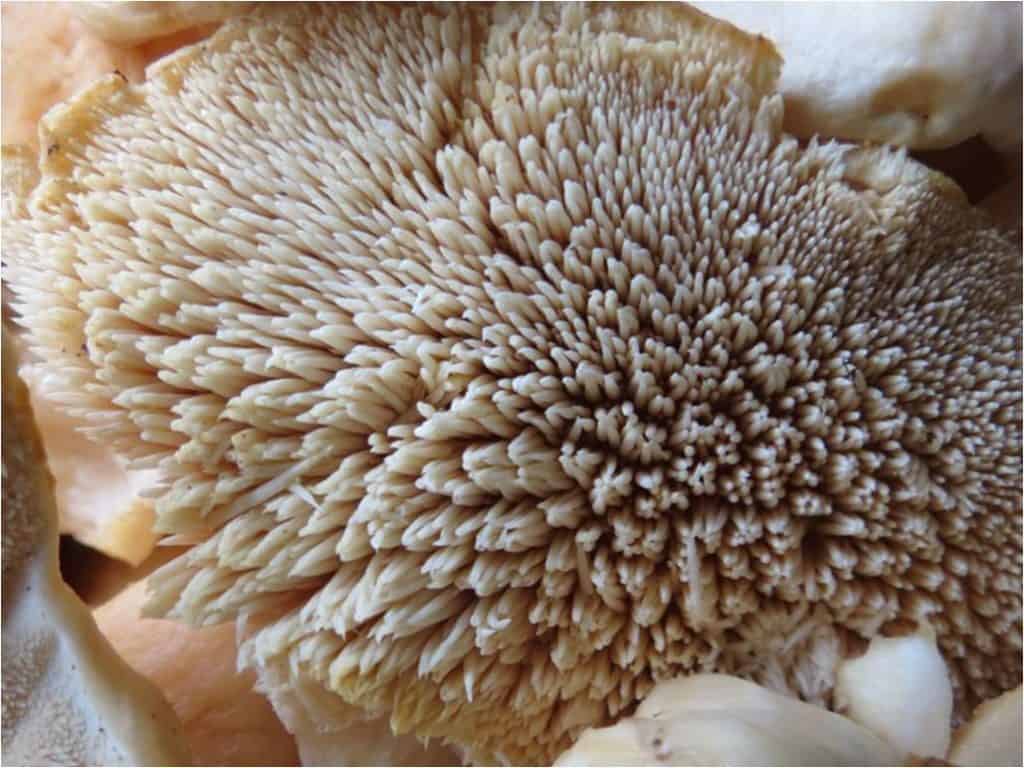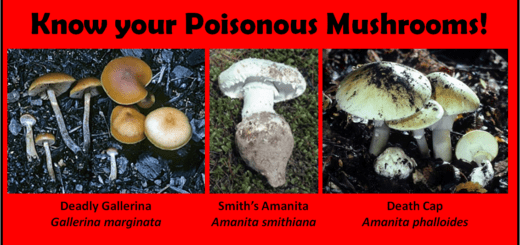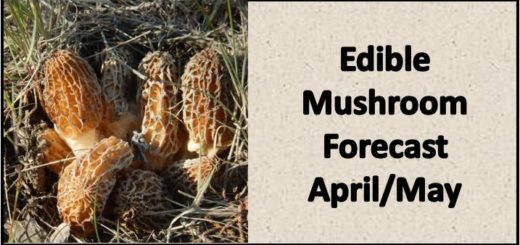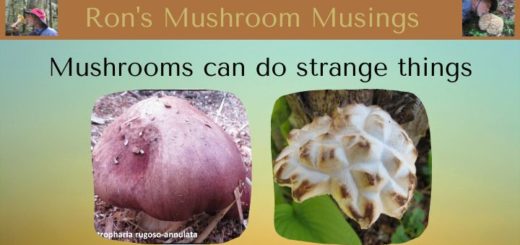Look Mom, No Cavities

I’d like to count myself as one of the few Homo sapiens to fall into the “no cavities” group. However, my mom told me it wasn’t nice to lie about stuff. On the other hand, most other genera of mammals living in the wild are fortunate enough to be able to brag about their cavityless choppers. Sharks even have this extraordinary and highly desirable ability to simply keep rotating in new teeth on a regular basis. But this article isn’t actually about a bunch of bragging cavityless mammals or toothed fish. Instead, it’s about a toothed mushroom, which can also lay claim to having a flawless dental record.

This month it is all about Hydnum repandum, mostly known in our area as the Hedgehog mushroom or sometimes ridiculously referred to as Sweet Tooth. The colloquial name of “Sweet Tooth” incorrectly implies that it only has a single tooth, loves sugary treats and would therefore require having a dentist on speed dial. H. repandum, appropriately referred to as the Hedgehog mushroom, is one of our favorites to find as it can become quite large and is very flavorful yet NOT sweet tasting.

Some can reach dinner plate size so it doesn’t take many of them to make a meal. That is actually a good thing as Sandy and I rarely find dense patches of this mushroom developing in easy to access areas. An obvious reason for that would be its popularity among many mushroom hunters. Subsequently, easily seen specimens are quickly snatched up. As for its greatly abundant teeth (also referred to as spines), they are densely-packed, large, soft to the touch and can be easily rubbed off. When bruised, the surface of this mushroom slowly stains to an orangish color. These features along with its creamy to beige to light-brown exterior color are great indicators that you have found the correct mushroom.
As for growth habit, H. repandum is not quick on the draw as it tends to develop over a long period of time. Under favorable conditions, dinner plate sized finds could have been developing for months before being found. When harvesting this mushroom, we tend to use a larger knife and reach slightly beneath the soil’s surface to obtain more of its quite hefty stem. It is best to remove as much debris from your Hedgehogs before putting them into your collecting container to avoid getting it imbedded in the difficult to clean toothed underside. You’ll thank yourself later. Mushroom websites that list its fruiting range here in Oregon say that it is mostly found in our coastal areas as well as the Cascade Mountain range. Smallish ones can be found soon after our fall rains start in earnest and can persist well into late winter.
As a side note, when we first stated harvesting H. repandum, it was suggested that leaving an exposed stem would allow it to develop a new cap. We have tried doing this without any successful outcomes and could not find any articles supporting this theory. If anyone does know of any scientifically based articles regarding regrowth of this species from a stem remnant, I would be very interested in reading them.

H. repandum does have a more abundantly available relative known as Hydnum umbilicatum, which is commonly refer to in our area as the Bellybutton Hedgehog. Inaturalist.org and a few other websites insist on referring to H. umbilicatum as the Depressed Hedgehog. Here again I believe this reference to be somewhat ridicules as it implies a need for psychiatric evaluation and/or psychological therapy.
On the positive side, H. umbilicatum also has an outstanding dental record equal to that of its larger cousin. However, based on its more petite size it would take quite a few more of them to equal just one full sized H. repandum. Our smaller H. umbilicatum tends to have a slightly peachier cap color, less extended teeth, and a “bellybutton” centered over its stem. It is quite brittle and we often find it in the company of Craterellus tubaeformis, commonly known as Yellowfoot, Winter Chanterelle, or Funnel Chanterelle. And, I am happy to say that all three of these common names seem perfectly rational. Both H. umbilicatum and C. tubaeformis have a much wider fruiting range, which extends from the coast to the Cascade Mountain range. They can also be found from late fall into early spring if conditions are right and they haven’t all been picked. While Oregon does have other toothed genera, H. repandum and H. umbilicatum are not easily confused with any of them.

As for cooking them up, I have pretty much converted to oven baking over that of stove top sautéing. This method requires a lot less attention and a greater number of mushrooms can be cooked at the same time given a large enough baking pan is used. After the mushrooms have been cleaned and sliced, I set the oven to 375? Fahrenheit to preheat. For baking, I’ve been using Pyrex pans that I coat with a little olive oil.
I also toss the mushrooms with some olive oil to help with browning. I do not apply any other seasoning to the mushrooms when baking them. This gives me more flexibility on how I want to use them at some later time. I like to slice my mushrooms on the thin side to accelerate the cooking process and once in the oven I stir them up after each 15-minute interval. After the second baking cycle or 30 minutes into baking, I drain off all the liquid in the baking dish to use as stock. This way I have a nice Mushroom flavored base for gravy or soup and draining off the liquid speeds up the mushroom browning process. If I find that my mushrooms are not browning as well as I would like, I will increase the oven temperature to 400? for the third and final baking cycle. Alternatively, a fourth 15-minute baking cycle at 375? could be used in place of increasing the oven temperature. For this batch of baked mushrooms, I used the drained off stock to make a vegetable soup with ramen noodles. Happy tummies were had by all. Actually, just Sandy and me.

On a related topic, as we are all very aware by now, every mushroom that researchers can get their hands on is being DNA sequenced. This process typically results in new genera being created and/or species name changes every few seconds. This should not be of any surprise to anyone who tries to learn a few scientific mushroom names only to find they are now outdated.
The genus Hydnum came under the microscope in 2018 and was subsequently determined to be more of a complex of species. Really? what a surprising outcome. As a result, we have now gone from our beloved two species to this new and improved list:
- Hydnum neorepandum (repandum being the European species name)
- Hydnum umbilicatum “complex” (I think they can squeeze out about 30 new species here)
- Hydnum oregonense
- Hydnum olympicum
- Hydnum subolympicum
- Hydnum melleopallidum
On the bright side, they are all still considered good edibles regardless of what scientific names they give them or how many times they split and re-split them up. In any event, I hope you have a great time in the woods and keep your eyes peeled for cavityless toothed, ground dwelling mushrooms. And, as your dentist would say, please floss and brush at least twice a day. Hopefully some genetic researcher can figure out how to use the genome editing system CRISPR to splice in the shark gene that keeps rotating in new teeth.
Ron – now known as the Ron Complex.





